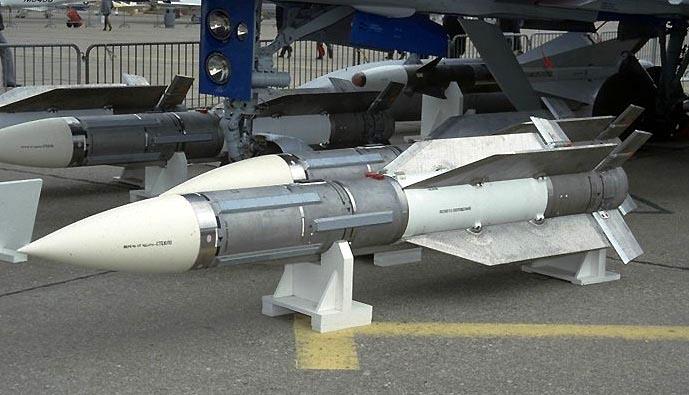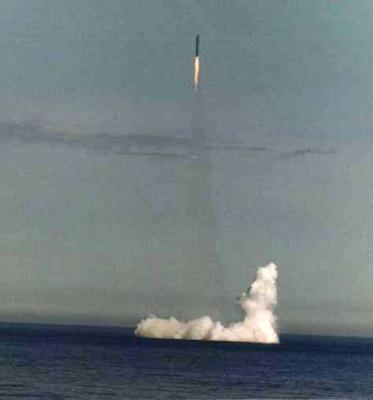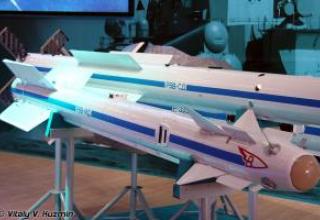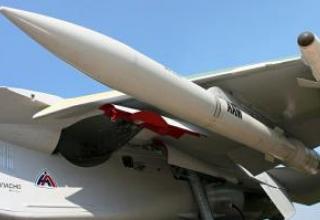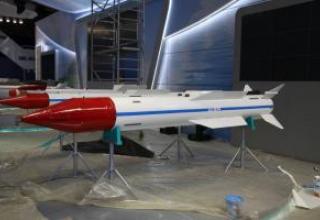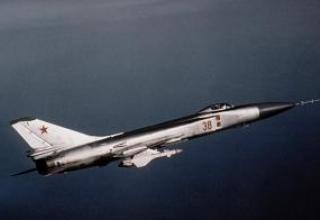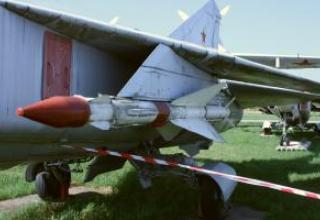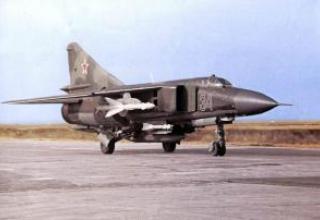The development of the R-33 long-range long-range missile for long-range interceptors was initiated by the Vimpel ICB in the late 1960s. This was the Soviet response to the US-designed F-14a fighter with the AIM-54A Phoenix missile. The R-33 missile together with the MiG-31 fighter made the Zaslon multichannel long-range intercept complex.
However, the concept of the domestic Zaslon complex differed significantly from the American one. The domestic complex was designed for territorial air defense of the country's regions with a rare network of airfields and ground guidance facilities. This required increased autonomy of operations, large intercept boundaries and zones of responsibility, multi-channel firing of targets within the entire set. To meet these requirements, the MiG-31 interceptor used a radar with a phased array antenna, which had much greater capability to search, detect, track and provide illumination of targets than the AWG-9 radar with a mechanical antenna. Due to practical inertia-free transfer of the station's beam from the PHAR in the multi-target illumination mode, it was possible to use semi-active radar in R-33 to ensure acceptable accuracy of guidance of four missiles to four targets simultaneously.
The entire control system of the complex, including the radar with the "Zaslon" and semi-active radar missiles, was developed by NPO "Phasotron" under the guidance of chief designer VK Grishin. According to the construction concept and implemented characteristics, the MiG-31 complex with the Zaslon radars has outperformed the level of foreign equipment and up to now retains leadership, having no close analogues abroad.
The missile is designed to intercept and destroy aircraft of various types, including low-altitude cruise missiles, at a distance of more than 100 km in autonomous and group actions of aircraft carriers, day and night, in simple and complex weather conditions, in the free space and on the background of the ground, in a wide range of altitudes and speeds of target flight.
August 28, 1978 was the first flight experiment in the world to simultaneously hit four radio-controlled targets missiles R-33 interceptor MiG-31 with a weapons control system (WMS) "Shutter". Four pilot R-33 missiles fired from a single fighter hit all four targets at the first time.
The state flight tests of the missile were completed in late 1980 on the MiG-31 prototype fighters. By the Decree of the CPSU Central Committee and the USSR CM of May 6, 1981 № 436-132 the first domestic long-range air-to-air missile R-33 was adopted for the Soviet army air defense aviation. It began to be equipped with interceptors for air targets MiG-31 as part of the intercept complexes MiG-31-33.
The first twenty R-33 missiles were mass-produced in Kaliningrad (Korolev), KPO "Strela" (now - the main enterprise of KTRV). After that the serial production was transferred to Dolgoprudnensky plant, where the missile was manufactured for more than ten years.
In the west, the missile was marked AA-9 AMOS.
A further development of the R-33 was the K-37M missile (item 610M), designed to arm the MiG-31BM interceptor.
Composition:
The fighter's powerful Shuttle Radar, which simultaneously escorts up to 10 targets, automatically selects the most dangerous ones and can lead four P-33s in one attack. In the barge flight of the fighter, the missiles are in a semi-submerged position under the fuselage to reduce resistance and increase patrol time. The missiles are launched with the help of catapult units AKU-33, bringing them to a sufficient distance from the aircraft. The location of the P-33 under the fuselage led to the peculiarities of its scheme - the inability to install a developed wing forced it to perform in the form of elongated ridges, and protruding beyond them the upper pair of rudders folded when the missile is on the suspension. At the same time, placing missiles under the fuselage in two successive echelons required limiting their length, making the hull compact and tightly packed. The diameter of the hull at the same time increased to 380 mm, which was dictated by the need to place the overall antenna RGSN.
Aerodynamic scheme of R-33 rocket is normal. Titanium and steel are widely used in the P-33 design, and the protection of swelling from kinetic heating in flight is provided by heat-insulating coating - sealant and heat-protective mats, without forced cooling system. The rocket engine - dual-mode, providing the starting acceleration and marching speed, is located near the center of gravity of the rocket. The power unit at the tail end includes gas generators for steering machines and a turbogenerator for power supply.
Long range of R-33 flight was achieved by application of two-stage guidance: inertial guidance on the first section and semi-active radar after capturing the target all-sky radar. Information on target movement is received by the missile from the launch vehicle prior to launch, and at the design point begins control of the GSN with the help of a fighter radar.
In the development of the R-33 its main probable enemy was defined as cruise missiles and strike aircraft, breaking through the boundaries of the air defense at low altitudes and under the cover of the means of REB. With this in mind, the guidance system of the complex has the ability to detect targets on the background of the ground, to recognize the nature and make a selection of interference. Thus, passive interference does not affect the operation of the WGSN at all. R-33 can hit targets flying at altitudes of 25 - 50 m to 26 - 28 km at speeds up to M = 3.5 with an excess or decrease relative to the carrier to 10 km, and simultaneously launched missiles can be guided by the "Shutter" on objects in the entire range of heights and ranges - from ground to the practical ceiling. Enemy aircraft maneuvering with 4g are destroyed with a probability of 0.6-0.8.
R-33 can be equipped with conventional or "special" (nuclear) BC, although the need to illuminate the target of the fighter's radar until it hits and limits the possibility of using missiles in a nuclear version (in order not to disrupt the guidance, after launch, the crew is forced to continue flying in the direction of the target). In the "power" version of the R-WZE, the missiles received an engine with extended operating time, which provided a longer range.
The missile's control system includes an inertial navigation system and a semi-active homing radar head.
Semi-active radar homing head developed by Research Institute "Agat", captures the target after launch from the aircraft carrier. Before capturing the homing of the missile is carried out inertial system. The length of the flight section before switching to homing is 10-20% of the entire length of the trajectory. Application of the missile provides an arms complex "Shutter" interceptor MiG-31. The MiG-31 is equipped with an onboard radar with a phased antenna array, capable of simultaneously directing 4 missiles to 4 targets flying at different altitudes.
The combat unit is a shrapnel-fire.
R-33 missile was first developed in parallel with the creation of the MiG-31 fighter and for the first time was used for its launch catapult launch with the help of ACS, built into the power circuit of the aircraft fuselage. This is an integrated solution of the joint design of the "catapult rocket plane", which has no analogues.
For the modernized interceptor MiG-31B, production of which began in 1990, was developed an improved version of the missile - R-33C with an active WGSN. R-33C - the first Soviet missile equipped with built-in digital BCVM.
The MiG-31M and MiG-31BM can be suspended up to 6 R-33C and simultaneously hit up to 6 targets.
Characteristics:
| R-33 | R-33С | R-33E | |
| Start range maximum,km | 120 | 160 | 160 |
| Flight Speed Maximum , M | 4.5 | - | 4.5 |
| The length of the rocket, mm | 4250 | - | 4150 |
| Maximum rocket body diameter, mm | 380 | - | 380 |
| Wingspan, mm | 900 | - | 900 |
| Wheelspan, mm | 1180 | - | 1180 |
| Start weight, kg | 491 | - | 490 |
| Weight of combat unit, kg | 55 | - | 47 |
| Maximum overload of affected targets | 8g | - | - |
| Maximum speed of the target, km/h. | 3700 | - | - |
Testing:
On August 6, 1991, at 9:07 p.m., salvo fire was fired with a full set of RSM-54 missiles from the 667BMBM submarine. The operation received the code "Begemot". In order to reduce costs, the operation was carried out for scheduled combat training of the submarine crew and regular flight of only two missiles. The missiles, which started in the first and last volley, had to complete the full flight program and hit the specified aiming points. The other missiles taking part in the salvo should have fully corresponded to the combat missiles in all the launch parameters, but the height of their flight could be arbitrary. To carry out the volley full ammunition was allocated submarine Novomoskovsk (commander of the boat SV Egorov) and 16 missiles RSM-54, manufactured by the Krasnoyarsk Engineering Plant. The launch was a success, so far no one in the world has been able to repeat the firing with full ammunition.
On June 5, 2001 the Northern Fleet's 667BMBM project (commander - 1st rank captain Mikhail Bannykh) successfully launched a ballistic missile from the Barents Sea. The missile was launched from an underwater hollow. The head of the rocket at a given time hit the target at the Kura test site in Kamchatka.
Sources:
- В.Марковский, К.Перов. Развитие советских авиационных ракет класса "воздух-воздух".М-Хобби.
- "Авиация и Космонавтика" 8'99
- "Агатовые" глаза ракет / "Вестник авиации и космонавтики" 1-2 99 /
- "Самолеты спецназначения" / В.Н.Шунков, 1998 /
- История и самолеты ОКБ МиГ / ООО "Крылья России", АНПК "МиГ", 1999, CD-ROM /
- AA-9 AMOS / FAS /
- Очерк истории создания отечественного управляемого оружия класса "воздух - воздух
- Р-33 (К-33, прототип К-100, изделие 410, AA-9 «Amos») /Настоящие сверхзвуковые! /
- http://vympelmkb.com/wp-content/uploads/2016/11/Gazeta-2016-10-Oktyabr-na-sajt.pdf
